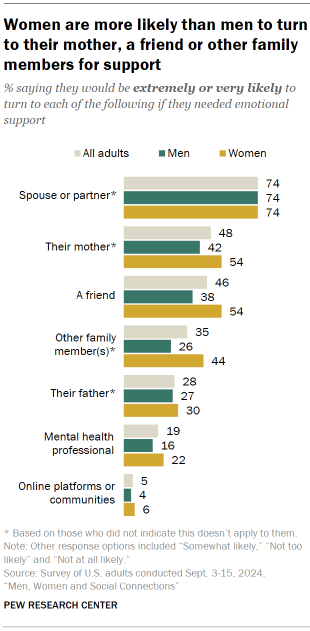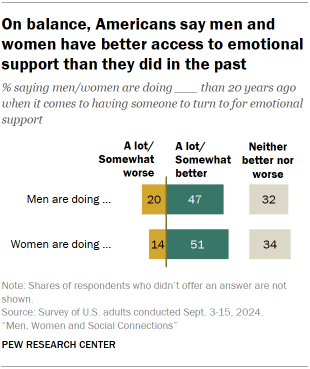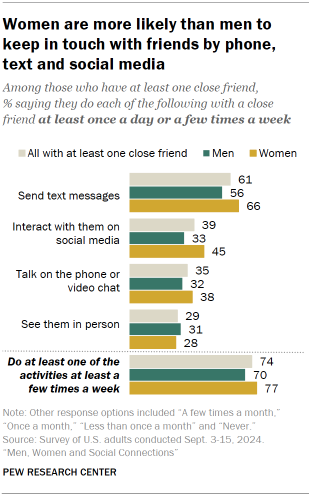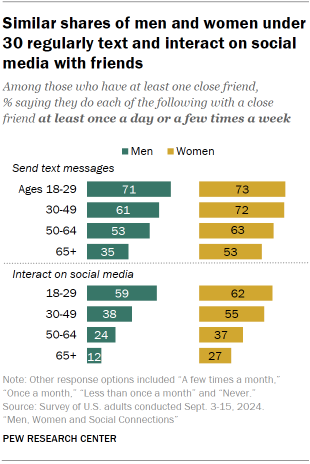
About three-quarters of U.S. adults (74%) say they would be extremely or very likely to turn to their spouse or partner if they needed emotional support.3
Men and women are equally likely to say they’d lean on their spouse or partner in this way.
Mothers and friends are also frequent sources of support: 48% of adults point to their mother and 46% point to a friend as someone they’d be extremely or very likely to go to. Smaller shares would go to their father (28%) or to another family member (35%).
There are significant gender differences when it comes to certain sources of support. By margins ranging from 12 to 18 percentage points, greater shares of women than men say they’d be extremely or very likely to turn to:
- Their mother (54% of women vs. 42% of men)
- A friend (54% vs. 38%)
- Another family member who is not their parent, spouse or partner (44% vs. 26%)
Turning to mental health professionals and online communities
Americans are less likely to say they’d turn to a mental health professional for emotional support than to say they’d turn to family or friends. About one-in-five adults (19%) say they’d be extremely or very likely to turn to a mental health professional for this type of support.
Some demographic groups are more likely than others to say they’d be extremely or very likely to seek out a mental health professional:
- Women are more likely to say this than men (22% vs. 16%).
- Black (26%) and Hispanic (25%) adults are more likely to say this than White (16%) and Asian (17%) adults.
- Adults younger than 50 are more likely to say this than those ages 50 and older (24% vs. 14%).
When it comes to seeking emotional support from online platforms or communities, relatively small shares of adults say they would be extremely or very likely to do this (5% overall).
Getting emotional support today versus 20 years ago

We also asked Americans how they think men and women are doing compared with 20 years ago in terms of having someone to turn to for emotional support. On balance, the public thinks men and women are doing better in this area than they were two decades ago.
Some 47% of adults say men are doing a lot or somewhat better, 20% say they’re doing a lot or somewhat worse, and 32% say they’re doing neither better nor worse. There’s a similar pattern for women: 51% say they’re doing better, 14% say they’re doing worse, and 34% say neither better nor worse.
Women are more likely than men to say that men are doing better these days when it comes to having someone to turn to for emotional support (51% vs. 42%). Similar shares of men (50%) and women (52%) say women are doing better compared with 20 years ago.
Communicating with friends
We also asked Americans about their friends and how they stay in touch with them. About eight-in-ten adults (81%) say they have at least one close friend – not counting their family members – and most (64%) have more than one close friend. About one-in-five (18%) say they don’t have any close friends.
Among adults who have close friends, 74% say they connect with one at least a few times a week, whether by texting, interacting on social media, talking on the phone or video chatting, or seeing them in person.
Texting is the most common form of communication between friends. Most adults with close friends (61%) say they text one either a few times a week or daily.
Sizable shares also interact with friends on social media (39%) or talk to them via phone or video chat (35%). About three-in-ten (29%) say they see a close friend in person at least a few times a week.
Differences by gender and age

There are large differences in how often men and women text or interact on social media with close friends. Women are more likely than men to say they communicate frequently in these ways by margins of 10 points or more.
Women are also somewhat more likely than men to talk on the phone or video chat with a close friend at least a few times a week (38% vs. 32%). But men (31%) are somewhat more likely than women (28%) to say they frequently see friends in person.

This gender gap is fairly consistent across adults ages 30 to 49, 50 to 64, and 65 and older. However, among those younger than 30, men and women are about equally likely to communicate with close friends in these ways.
Looking just at age, adults younger than 30 are the most likely to say they text (72%) or interact on social media (60%) with a close friend at least a few times a week. Those ages 65 and older are the least likely to say they regularly use these forms of communication.




